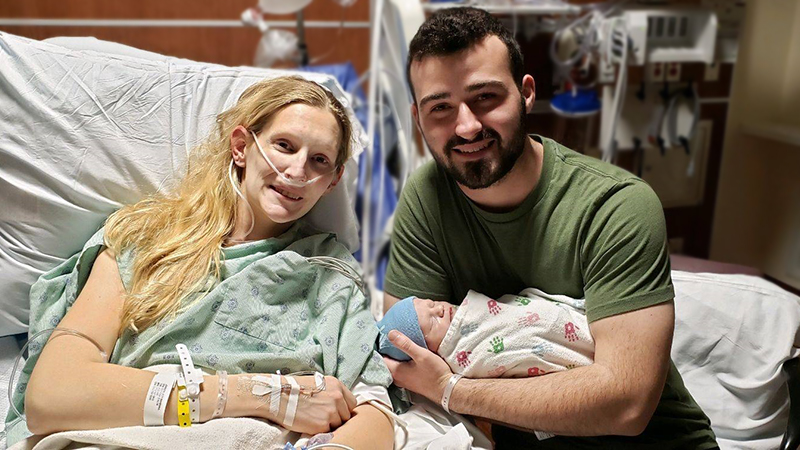Coder Uses Brain Computer to Shut Down Seizures
Published October 2020
Controlling Epilepsy With Technology
Alec’s bedtime routine looks a bit different than the average 23-year-old’s. He brushes his teeth, winds down on his phone and hangs out with his cat Duke. Then he holds a wand up to his skull and uploads his brainwaves from a tiny computer in his head to the cloud. Miles away the next day, Northwestern Medicine Neurologist Jessica W. Templer, MD, and her team download and examine Alec’s brain activity.
Alec was diagnosed with epilepsy at age 12. Since then, Alec’s life has been a storm of doctor’s office visits, medications and lifestyle modifications to manage his seizures. That was until a high-tech solution offered Alec a clear, calm horizon.
Alec has the RNS® System. It’s connected to electrodes that sit on the areas of the brain where his seizures start. It learns the patterns of his seizures and then delivers an electric pulse to stop them.
“A seizure is like a neuron ‘flash mob,’” says Dr. Templer. “One neuron starts misfiring, and then it recruits more neurons to start misfiring, and so on. The goal of the RNS is to stop these neurons from firing so that patients have less frequent seizures with less medication.”
The RNS has empowered Alec to wean off the many medications affecting his quality of life and budding career as a computer coder.
And it will only get better.
“The RNS improves in efficacy over time by learning the difference between normal and abnormal brainwaves,” says Northwestern Medicine Neurosurgeon and epilepsy care advocate Sarah K. Bandt, MD. “This is artificial intelligence in medicine at its best.”
This is artificial intelligence in medicine at its best.— Sarah K. Bandt, MD
Before the RNS, Alec worked with care teams in the Chicagoland area, including Northwestern Medicine Central DuPage Hospital, a National Association of Epilepsy Centers (NAEC)Level 3 Epilepsy Center, to find the right combination of medications to help reduce the number and intensity of his seizures. However, this meant being on up to six medications at once, each of which has its own side effects. Alec, a bright and curious young man, felt perpetually foggy and forgetful. He felt like epilepsy was defining his life in a way he didn’t want.
A Roadmap for RNS
A brain computer for a computer programmer seemed like the perfect fit, and, as it turns out, Alec was a good candidate for it. He has focal epilepsy, which means his seizures start in a specific part of his brain and therefore affect one part of his body: his right arm.
“The old standard for focal epilepsy was to identify the part of the brain where the seizures originated and surgically remove it if it wasn’t vital,” says Dr. Bandt. For many patients, this works. Because their seizures do not start in areas of the brain that are critical for function, removing the part of the brain where seizures start can cure some people.
“In Alec’s case, this was not an option. This surgery would’ve caused Alec to lose function in his right arm. The RNS was an ideal solution,” adds Dr. Bandt.
It took great collaboration between specialties, and Dr. Bandt and Dr. Templer’s teams, at Northwestern Memorial Hospital, an NAEC Level 4 Epilepsy Center, before Alec was finally approved to receive an RNS.
He began a marathon of procedures to map out his brain in preparation for receiving the RNS system. First, he had an electroencephalogram (EEG) to measure his brain activity with a net of electrodes outside of his scalp. Dr. Bandt calls this “finding the ZIP code” of his seizure origin.
Then, Alec had a preliminary surgery to implant temporary electrodes around the area where his neurology team believed his seizures were occurring. Dr. Bandt equates this to finding the exact address of Alec’s seizures. Alec stayed in the hospital for one week while Dr. Templer and her team charted his brain activity with the temporary electrodes.
Once the team had a road map, Alec went back in for his final surgery. Dr. Bandt put the electrodes exactly where Alec’s seizures start and implanted the computer chip into his skull. She placed the battery in a strategic spot so that when it’s time to exchange it — in about seven years when the battery will run out — she’ll be able to access it with a simple outpatient procedure.
Once activated, the RNS started recording Alec’s brain activity. But before it could stop his seizures, it had to learn how to detect them.
Dr. Templer plays a key role in fine-tuning the algorithm of Alec’s RNS system so that it can effectively detect and abort his seizures. She reviews the data from the RNS system monthly to teach the device Alec’s seizure patterns. When Alec comes into her office, Dr. Templer programs the RNS bit by bit so that it can eventually identify and stop a seizure within milliseconds.
Restarting
It’s working.
“I’ve actually felt an aura in my hand at the onset of a seizure and then felt the seizure dissipate,” says Alec. “It’s pretty remarkable.”
The goal is for Alec to eventually not feel those seizure symptoms at all, and to wean off some of his medications. This will take time and patience, but Alec, Dr. Bandt and Dr. Templer are committed.
“I really don’t like defining my life by epilepsy, but it’s been a pillar that’s affected all my choices,” he says. “I’m ready to start a new part of my life.”







